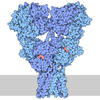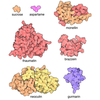[English] 日本語
 Yorodumi
Yorodumi- EMDB-47298: Ligand-binding and transmembrane domains of kainate receptor GluK... -
+ Open data
Open data
- Basic information
Basic information
| Entry |  | |||||||||||||||
|---|---|---|---|---|---|---|---|---|---|---|---|---|---|---|---|---|
| Title | Ligand-binding and transmembrane domains of kainate receptor GluK2 in complex with positive allosteric modulator BPAM-344 and channel blocker Kukoamine-A | |||||||||||||||
 Map data Map data | Ligand-binding and transmembrane domains of kainate receptor GluK2 in complex with positive allosteric modulator BPAM-344 and channel blocker Kukoamine-A | |||||||||||||||
 Sample Sample |
| |||||||||||||||
 Keywords Keywords | Kainate receptor / GluK2 / Positive allosteric modulator / BPAM344 / Channel blocker / Kukoamine-A / membrane protein | |||||||||||||||
| Function / homology |  Function and homology information Function and homology informationmossy fiber rosette / detection of cold stimulus involved in thermoception / Activation of Na-permeable kainate receptors / kainate selective glutamate receptor complex / Activation of Ca-permeable Kainate Receptor / regulation of short-term neuronal synaptic plasticity / glutamate receptor activity / ubiquitin conjugating enzyme binding / negative regulation of synaptic transmission, glutamatergic / regulation of JNK cascade ...mossy fiber rosette / detection of cold stimulus involved in thermoception / Activation of Na-permeable kainate receptors / kainate selective glutamate receptor complex / Activation of Ca-permeable Kainate Receptor / regulation of short-term neuronal synaptic plasticity / glutamate receptor activity / ubiquitin conjugating enzyme binding / negative regulation of synaptic transmission, glutamatergic / regulation of JNK cascade / inhibitory postsynaptic potential / receptor clustering / kainate selective glutamate receptor activity / modulation of excitatory postsynaptic potential / extracellularly glutamate-gated ion channel activity / ionotropic glutamate receptor complex / positive regulation of synaptic transmission / behavioral fear response / neuronal action potential / glutamate-gated receptor activity / glutamate-gated calcium ion channel activity / ligand-gated monoatomic ion channel activity involved in regulation of presynaptic membrane potential / presynaptic modulation of chemical synaptic transmission / dendrite cytoplasm / hippocampal mossy fiber to CA3 synapse / SNARE binding / regulation of membrane potential / excitatory postsynaptic potential / transmitter-gated monoatomic ion channel activity involved in regulation of postsynaptic membrane potential / synaptic transmission, glutamatergic / PDZ domain binding / regulation of long-term neuronal synaptic plasticity / postsynaptic density membrane / modulation of chemical synaptic transmission / intracellular calcium ion homeostasis / terminal bouton / positive regulation of neuron apoptotic process / presynaptic membrane / neuron apoptotic process / scaffold protein binding / perikaryon / chemical synaptic transmission / negative regulation of neuron apoptotic process / postsynaptic membrane / postsynaptic density / axon / neuronal cell body / ubiquitin protein ligase binding / synapse / dendrite / glutamatergic synapse / identical protein binding / membrane / plasma membrane Similarity search - Function | |||||||||||||||
| Biological species |  | |||||||||||||||
| Method | single particle reconstruction / cryo EM / Resolution: 3.75 Å | |||||||||||||||
 Authors Authors | Yen LY / Newton TP / Gangwar SP / Yelshanskaya MV / Sobolevsky AI | |||||||||||||||
| Funding support |  United States, 4 items United States, 4 items
| |||||||||||||||
 Citation Citation |  Journal: Nat Commun / Year: 2024 Journal: Nat Commun / Year: 2024Title: Trapping of spermine, Kukoamine A, and polyamine toxin blockers in GluK2 kainate receptor channels. Authors: Shanti Pal Gangwar / Maria V Yelshanskaya / Muhammed Aktolun / Laura Y Yen / Thomas P Newton / Kristian Strømgaard / Maria G Kurnikova / Alexander I Sobolevsky /   Abstract: Kainate receptors (KARs) are a subtype of ionotropic glutamate receptor (iGluR) channels, a superfamily of ligand-gated ion channels which mediate the majority of excitatory neurotransmission in the ...Kainate receptors (KARs) are a subtype of ionotropic glutamate receptor (iGluR) channels, a superfamily of ligand-gated ion channels which mediate the majority of excitatory neurotransmission in the central nervous system. KARs modulate neuronal circuits and plasticity during development and are implicated in neurological disorders, including epilepsy, depression, schizophrenia, anxiety, and autism. Calcium-permeable KARs undergo ion channel block, but the therapeutic potential of channel blockers remains underdeveloped, mainly due to limited structural knowledge. Here, we present closed-state structures of GluK2 KAR homotetramers in complex with ion channel blockers NpTx-8, PhTx-74, Kukoamine A, and spermine. We find that blockers reside inside the GluK2 ion channel pore, intracellular to the closed M3 helix bundle-crossing gate, with their hydrophobic heads filling the central cavity and positively charged polyamine tails spanning the selectivity filter. Molecular dynamics (MD) simulations of our structures illuminate interactions responsible for different affinity and binding poses of the blockers. Our structures elucidate the trapping mechanism of KAR channel block and provide a template for designing new blockers that can selectively target calcium-permeable KARs in neuropathologies. | |||||||||||||||
| History |
|
- Structure visualization
Structure visualization
| Supplemental images |
|---|
- Downloads & links
Downloads & links
-EMDB archive
| Map data |  emd_47298.map.gz emd_47298.map.gz | 166.9 MB |  EMDB map data format EMDB map data format | |
|---|---|---|---|---|
| Header (meta data) |  emd-47298-v30.xml emd-47298-v30.xml emd-47298.xml emd-47298.xml | 19 KB 19 KB | Display Display |  EMDB header EMDB header |
| FSC (resolution estimation) |  emd_47298_fsc.xml emd_47298_fsc.xml | 11.9 KB | Display |  FSC data file FSC data file |
| Images |  emd_47298.png emd_47298.png | 63.9 KB | ||
| Filedesc metadata |  emd-47298.cif.gz emd-47298.cif.gz | 6.9 KB | ||
| Others |  emd_47298_half_map_1.map.gz emd_47298_half_map_1.map.gz emd_47298_half_map_2.map.gz emd_47298_half_map_2.map.gz | 164.8 MB 164.8 MB | ||
| Archive directory |  http://ftp.pdbj.org/pub/emdb/structures/EMD-47298 http://ftp.pdbj.org/pub/emdb/structures/EMD-47298 ftp://ftp.pdbj.org/pub/emdb/structures/EMD-47298 ftp://ftp.pdbj.org/pub/emdb/structures/EMD-47298 | HTTPS FTP |
-Validation report
| Summary document |  emd_47298_validation.pdf.gz emd_47298_validation.pdf.gz | 821.7 KB | Display |  EMDB validaton report EMDB validaton report |
|---|---|---|---|---|
| Full document |  emd_47298_full_validation.pdf.gz emd_47298_full_validation.pdf.gz | 821.3 KB | Display | |
| Data in XML |  emd_47298_validation.xml.gz emd_47298_validation.xml.gz | 20.6 KB | Display | |
| Data in CIF |  emd_47298_validation.cif.gz emd_47298_validation.cif.gz | 26.6 KB | Display | |
| Arichive directory |  https://ftp.pdbj.org/pub/emdb/validation_reports/EMD-47298 https://ftp.pdbj.org/pub/emdb/validation_reports/EMD-47298 ftp://ftp.pdbj.org/pub/emdb/validation_reports/EMD-47298 ftp://ftp.pdbj.org/pub/emdb/validation_reports/EMD-47298 | HTTPS FTP |
-Related structure data
| Related structure data |  9dxtMC  9dxqC  9dxrC  9dxsC M: atomic model generated by this map C: citing same article ( |
|---|---|
| Similar structure data | Similarity search - Function & homology  F&H Search F&H Search |
- Links
Links
| EMDB pages |  EMDB (EBI/PDBe) / EMDB (EBI/PDBe) /  EMDataResource EMDataResource |
|---|---|
| Related items in Molecule of the Month |
- Map
Map
| File |  Download / File: emd_47298.map.gz / Format: CCP4 / Size: 178 MB / Type: IMAGE STORED AS FLOATING POINT NUMBER (4 BYTES) Download / File: emd_47298.map.gz / Format: CCP4 / Size: 178 MB / Type: IMAGE STORED AS FLOATING POINT NUMBER (4 BYTES) | ||||||||||||||||||||||||||||||||||||
|---|---|---|---|---|---|---|---|---|---|---|---|---|---|---|---|---|---|---|---|---|---|---|---|---|---|---|---|---|---|---|---|---|---|---|---|---|---|
| Annotation | Ligand-binding and transmembrane domains of kainate receptor GluK2 in complex with positive allosteric modulator BPAM-344 and channel blocker Kukoamine-A | ||||||||||||||||||||||||||||||||||||
| Projections & slices | Image control
Images are generated by Spider. | ||||||||||||||||||||||||||||||||||||
| Voxel size | X=Y=Z: 1.069 Å | ||||||||||||||||||||||||||||||||||||
| Density |
| ||||||||||||||||||||||||||||||||||||
| Symmetry | Space group: 1 | ||||||||||||||||||||||||||||||||||||
| Details | EMDB XML:
|
-Supplemental data
-Half map: #2
| File | emd_47298_half_map_1.map | ||||||||||||
|---|---|---|---|---|---|---|---|---|---|---|---|---|---|
| Projections & Slices |
| ||||||||||||
| Density Histograms |
-Half map: #1
| File | emd_47298_half_map_2.map | ||||||||||||
|---|---|---|---|---|---|---|---|---|---|---|---|---|---|
| Projections & Slices |
| ||||||||||||
| Density Histograms |
- Sample components
Sample components
-Entire : Ligand-binding and transmembrane domains of kainate receptor GluK...
| Entire | Name: Ligand-binding and transmembrane domains of kainate receptor GluK2 in complex with positive allosteric modulator BPAM-344 and channel blocker Kukoamine-A |
|---|---|
| Components |
|
-Supramolecule #1: Ligand-binding and transmembrane domains of kainate receptor GluK...
| Supramolecule | Name: Ligand-binding and transmembrane domains of kainate receptor GluK2 in complex with positive allosteric modulator BPAM-344 and channel blocker Kukoamine-A type: complex / ID: 1 / Parent: 0 / Macromolecule list: #1 |
|---|---|
| Source (natural) | Organism:  |
-Macromolecule #1: Glutamate receptor ionotropic, kainate 2
| Macromolecule | Name: Glutamate receptor ionotropic, kainate 2 / type: protein_or_peptide / ID: 1 / Number of copies: 4 / Enantiomer: LEVO |
|---|---|
| Source (natural) | Organism:  |
| Molecular weight | Theoretical: 102.509977 KDa |
| Recombinant expression | Organism:  Homo sapiens (human) Homo sapiens (human) |
| Sequence | String: MKIISPVLSN LVFSRSIKVL LCLLWIGYSQ GTTHVLRFGG IFEYVESGPM GAEELAFRFA VNTINRNRTL LPNTTLTYDT QKINLYDSF EASKKACDQL SLGVAAIFGP SHSSSANAVQ SICNALGVPH IQTRWKHQVS DNKDSFYVSL YPDFSSLSRA I LDLVQFFK ...String: MKIISPVLSN LVFSRSIKVL LCLLWIGYSQ GTTHVLRFGG IFEYVESGPM GAEELAFRFA VNTINRNRTL LPNTTLTYDT QKINLYDSF EASKKACDQL SLGVAAIFGP SHSSSANAVQ SICNALGVPH IQTRWKHQVS DNKDSFYVSL YPDFSSLSRA I LDLVQFFK WKTVTVVYDD STGLIRLQEL IKAPSRYNLR LKIRQLPADT KDAKPLLKEM KRGKEFHVIF DCSHEMAAGI LK QALAMGM MTEYYHYIFT TLDLFALDVE PYRYSGVNMT GFRILNTENT QVSSIIEKWS MERLQAPPKP DSGLLDGFMT TDA ALMYDA VHVVSVAVQQ FPQMTVSSLQ CNRHKPWRFG TRFMSLIKEA HWEGLTGRIT FNKTNGLRTD FDLDVISLKE EGLE KIGTW DPASGLNMTE SQKGKPANIT DSLSNRSLIV TTILEEPYVL FKKSDKPLYG NDRFEGYCID LLRELSTILG FTYEI RLVE DGKYGAQDDV NGQWNGMVRE LIDHKADLAV APLAITYVRE KVIDFSKPFM TLGISILYRK PNGTNPGVFS FLNPLS PDI WMYVLLACLG VSCVLFVIAR FSPYEWYNPH PCNPDSDVVE NNFTLLNSFW FGVGALMQQG SELMPKALST RIVGGIW WF FTLIIISSYT ANLAAFLTVE RMESPIDSAD DLAKQTKIEY GAVEDGATMT FFKKSKISTY DKMWAFMSSR RQSVLVKS N EEGIQRVLTS DYAFLMESTT IEFVTQRNCN LTQIGGLIDS KGYGVGTPMG SPYRDKITIA ILQLQEEGKL HMMKEKWWR GNGCPEEESK EASALGVQNI GGIFIVLAAG LVLSVFVAVG EFLYKSKKNA QLEKRSFCSA MVEELRMSLK CQRRLKHKPQ APVIVKTEE VINMHTFNDR RLPGKETMA UniProtKB: Glutamate receptor ionotropic, kainate 2 |
-Macromolecule #2: 4-cyclopropyl-7-fluoro-3,4-dihydro-2H-1,2,4-benzothiadiazine 1,1-...
| Macromolecule | Name: 4-cyclopropyl-7-fluoro-3,4-dihydro-2H-1,2,4-benzothiadiazine 1,1-dioxide type: ligand / ID: 2 / Number of copies: 4 / Formula: 2J9 |
|---|---|
| Molecular weight | Theoretical: 242.27 Da |
| Chemical component information |  ChemComp-2J9: |
-Macromolecule #3: (2S)-3-(hexadecanoyloxy)-2-[(9Z)-octadec-9-enoyloxy]propyl 2-(tri...
| Macromolecule | Name: (2S)-3-(hexadecanoyloxy)-2-[(9Z)-octadec-9-enoyloxy]propyl 2-(trimethylammonio)ethyl phosphate type: ligand / ID: 3 / Number of copies: 8 / Formula: POV |
|---|---|
| Molecular weight | Theoretical: 760.076 Da |
| Chemical component information |  ChemComp-POV: |
-Macromolecule #4: 2-acetamido-2-deoxy-beta-D-glucopyranose
| Macromolecule | Name: 2-acetamido-2-deoxy-beta-D-glucopyranose / type: ligand / ID: 4 / Number of copies: 16 / Formula: NAG |
|---|---|
| Molecular weight | Theoretical: 221.208 Da |
| Chemical component information |  ChemComp-NAG: |
-Macromolecule #5: CHOLESTEROL
| Macromolecule | Name: CHOLESTEROL / type: ligand / ID: 5 / Number of copies: 8 / Formula: CLR |
|---|---|
| Molecular weight | Theoretical: 386.654 Da |
| Chemical component information |  ChemComp-CLR: |
-Macromolecule #6: 1-deoxy-alpha-D-mannopyranose
| Macromolecule | Name: 1-deoxy-alpha-D-mannopyranose / type: ligand / ID: 6 / Number of copies: 4 / Formula: AH2 |
|---|---|
| Molecular weight | Theoretical: 164.156 Da |
| Chemical component information |  ChemComp-AH2: |
-Macromolecule #7: N,N'-[butane-1,4-diylbis(azanediylpropane-3,1-diyl)]bis[3-(3,4-di...
| Macromolecule | Name: N,N'-[butane-1,4-diylbis(azanediylpropane-3,1-diyl)]bis[3-(3,4-dihydroxyphenyl)propanamide] type: ligand / ID: 7 / Number of copies: 1 / Formula: A1BDT |
|---|---|
| Molecular weight | Theoretical: 530.656 Da |
-Experimental details
-Structure determination
| Method | cryo EM |
|---|---|
 Processing Processing | single particle reconstruction |
| Aggregation state | particle |
- Sample preparation
Sample preparation
| Buffer | pH: 8 Component:
| ||||||||||
|---|---|---|---|---|---|---|---|---|---|---|---|
| Grid | Model: UltrAuFoil R1.2/1.3 / Material: GOLD / Support film - Material: GOLD / Support film - topology: HOLEY | ||||||||||
| Vitrification | Cryogen name: ETHANE |
- Electron microscopy
Electron microscopy
| Microscope | TFS KRIOS |
|---|---|
| Image recording | Film or detector model: GATAN K3 (6k x 4k) / Average electron dose: 47.25 e/Å2 |
| Electron beam | Acceleration voltage: 300 kV / Electron source:  FIELD EMISSION GUN FIELD EMISSION GUN |
| Electron optics | Illumination mode: FLOOD BEAM / Imaging mode: BRIGHT FIELD / Nominal defocus max: 2.0 µm / Nominal defocus min: 1.0 µm |
| Experimental equipment |  Model: Titan Krios / Image courtesy: FEI Company |
+ Image processing
Image processing
-Atomic model buiding 1
| Refinement | Space: REAL |
|---|---|
| Output model |  PDB-9dxt: |
 Movie
Movie Controller
Controller








 X (Sec.)
X (Sec.) Y (Row.)
Y (Row.) Z (Col.)
Z (Col.)





































